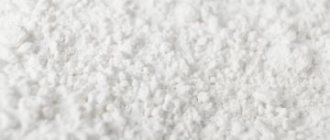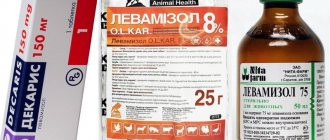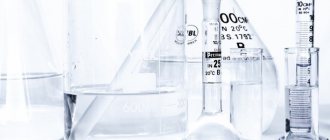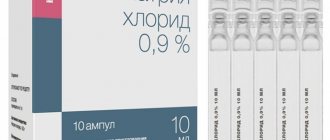Feed enzyme "Pepsin" - a necessity in feeding young farm animals
24.02.2016
B. T. Abilov, head of the feeding department of the Federal State Budgetary Institution VNIIOK, candidate of agricultural sciences. Sciences, Associate Professor, I. A. Sinelshchikova, Senior Researcher, Candidate of Sciences. agricultural Sciences, L. A. Pashkova, senior researcher, Ph.D. agricultural Sciences, N. A. Bolotov, senior researcher, Ph.D. agricultural Sciences, A.I. Zarytovsky, senior researcher, Ph.D. biol. Sciences, Associate Professor (Federal State Budgetary Scientific Institution “All-Russian Research Institute of Sheep and Goat Breeding” (FGBNU VNIIOK), Stavropol).
In increasing the production of livestock products, one of the key problems remains the balance of diets with a complex of essential nutrients in accordance with detailed feeding standards [1, 2, 3, 4, 5].
Among diseases of young farm animals, diarrhea (dyspepsia) occupies a special place. Therefore, dyspepsia in newborn calves occupies a leading place among non-contagious pathologies of young animals in terms of frequency, prevalence and amount of economic damage. This disease affects from 50 to 100% of young cattle, when death from diarrhea can reach up to 50% of the number of animals born.
Young animals that have suffered from toxic diarrhea regain their original weight by about 20 days of age, but their growth energy remains low for a long time. Cows that have suffered from diarrhea at an early age have reduced milk production (by approximately 10–15%) and the ability to reproduce the herd. The economic damage from diarrhea also includes the money and time that have to be spent on treating sick calves. To reduce losses, generally accepted methods of treating animals are used, aimed at restoring impaired digestion, suppressing pathogenic and conditionally pathogenic microflora, normalizing water-salt and acid-base balance, and increasing the body's resistance. It should be noted that for the prevention and treatment of diseases of the gastrointestinal tract of young young animals, the use of antimicrobial drugs (AMD) often does not bring the desired success. The use of vaccines at this age is also ineffective, since the immune system of animals is not yet sufficiently developed, the level of colostral immunity is minimal, and at the same time, some of the colostral antibodies can be blocked by the antigens of the administered vaccines, aggravating the infectious process.
Therefore, it is recommended to use the natural drug “Pepsin”, an enzyme from the gastric juice of animals, for the prevention of gastrointestinal diseases, as well as to improve the economically useful traits of animals. Pepsin is a proteolytic enzyme that breaks down proteins mainly into polypeptides.
The purpose of our research was to study the effect of the enzyme preparation “Pepsin” in the starter feed on the productive qualities of young goats and sheep. In accordance with this goal, the following tasks were set:
- determine the chemical composition and nutritional value of feed used in the diets of young small cattle;
- study the morphological and biochemical parameters of the blood of kids and lambs at 4 months of age;
- the influence of the enzyme preparation "Pepsin" on the productivity of young goats and sheep.
The work was carried out at the experimental station of the Federal State Budgetary Institution VNIIOK in the period from September to November 2015.
For these purposes, 3 groups of analogues of kids and lambs at 3 months of age were formed according to live weight and origin and tested according to the following scheme (Table 1). Table 1. Experimental scheme.
| Group | Breed | Number of animals, heads. | Duration of experiment, days. | Features of feeding |
| Goats and lambs | ||||
| Ι-control | Saanen / Poll Dorset | 12 | 60 | Feeding ration according to VIZH standards (mixed grass hay, starter feed, mineral feed: salt and chalk) - OR |
| ΙΙ-experienced | 12 | OP + feed additive "Acibif" 20 g/head. | ||
| ΙΙΙ-experienced | 12 | OP + feed additive "Pepsin" 0.7 g/bird | ||
The goats were kept indoors under the same conditions of housing and feeding and were served by one operator. The lambs were in a different production facility, also under the same conditions of housing and feeding, and were served by an operator who also looked after the kids.
According to the experimental design (Table 1), the Ι-control group received a diet according to the recommendations of VNIIOK and VIZH (Kalashnikov A.P., 1985, 2003). The second experimental group received in addition to the main diet the probiotic preparation “Acibif” in a dose of 20 g/animal, and the third group received the enzyme preparation “Pepsin” in an amount of 0.7 g/animal. The experiment lasted for 60 days. The animals received feed preparations in prescribed doses as part of the starter feed and were mixed before feeding.
The feeding rations consisted of starter feed, which was prepared according to VNIIOK recipes at the Novoaleksandrovsky feed mill, mixed-grass hay, mineral feed (table salt, chalk), which were balanced for all essential nutrients. Chemical analysis of feed was carried out in the laboratory of infectious, non-contagious and parasitic diseases of VNIIOK and confirmed the high quality of both feed and feed additives. So the hay had a nutritional value of 0.51 feed. units with a digestible protein content of 48 g per 1 kg of feed.
The feed starter, prepared at Novoaleksandrovskoe feed mill, had the following composition: wheat, barley, wheat bran, sunflower and soybean meal, grass flour, milk powder, monocalcium phosphate, feed yeast with a crude protein content of 17.1%, fiber - 7.8% with exchange energy – 12.0 MJ, that is, the nutritional value of the feed alone is 12.0 EKE.
During the research period of 60 days, the following results were obtained, which showed the following growth dynamics of young goats and sheep (Table 2).
Table 2. Dynamics of growth of live weight of young animals.
| Group | Goats | Lambs | ||||||||||
| Live weight, kg | Growth | in % to control | % of diseases | Live weight, kg | Growth | in % to control | % of diseases | |||||
| when setting | upon completion | absolute, kg | average daily, g | when setting | upon completion | absolute, kg | average daily, g | |||||
| Ι-control | 16,34 | 20,65 | 4,31 | 88 | 100,0 | 16,6 | 17,46 | 24,72 | 7,26 | 121 | 100,0 | 8,3 |
| ΙΙ-experienced | 16,14 | 21,41 | 5,27 | 108 | 108,0 | — | 17,43 | 25,35 | 7,92 | 132 | 109,1 | — |
| ΙΙΙ-experienced | 16,74 | 22,47 | 5,73 | 117 | 132,9 | — | 17,40 | 26,52 | 9,12 | 151 | 124,8 | — |
When using feed preparations when feeding young goats and lambs as part of a starter feed, they showed a positive trend in live weight gain. Thus, in terms of average daily growth, the best results were shown by experimental animals whose diet included the drug “Pepsin”. Young goats and sheep outperformed their peers in the control group by 32.9 and 24.8%, animals of experimental group II by 24.9 and 15.7%. Consequently, feeding young animals with the enzyme preparation “Pepsin”, separated from their mothers at an early age for 1–1.5 months, gives positive results; Feeding this drug also has a positive effect on the safety of young animals, which indicates the absence of gastrointestinal diseases, whereas in the control group this figure was 16.6%.
During the scientific and economic experiment, we conducted biochemical and morphological blood tests.
Blood was taken for analysis from three animals in the control group: kids and lambs. The amount of hemoglobin, erythrocytes, leukocytes, total protein, albumins, and globulins was determined in the blood (Table 3). Table 3. Results of blood protein metabolism.
| Indicators | Goats | Lambs | ||||
| group | ||||||
| Ι | ΙΙ | ΙΙΙ | Ι | ΙΙ | ΙΙΙ | |
| Red blood cells, 1012/l | 8,51 | 8,73 | 8,84 | 8,24 | 8,84 | 8,47 |
| Hemoglobin, g/l | 116,0 | 121,2 | 127,8 | 108,84 | 112,86 | 109,85 |
| Leukocytes, 109/l | 8,90 | 9,21 | 9,42 | 9,47 | 9,84 | 10,18 |
| Total protein, g/l | 64,4 | 65,5 | 67,2 | 59,16 | 63,15 | 65,74 |
| Albumin, g/l | 23,67 | 24,01 | 24,55 | 34,55 | 35,82 | 37,10 |
| Globulins, g/l | 11,02 | 11,84 | 11,88 | 33,25 | 34,74 | 35,11 |
An analysis of the table shows that the use of feed additives in the diet when raising kids and lambs affects the physiological parameters of the blood. If the difference in the content of erythrocytes, hemoglobin and leukocytes is insignificant, then in the content of total protein this difference reaches 11.1%, which affected the dynamics of growth. However, the level of albumin and globulin was within the upper limit of the physiological norm.
When conducting research on the use of probiotic and enzyme preparations "Acibif" and "Pepsin" as part of the diet of lambs and kids, it was necessary to ensure the positive effect of these feed additives.
For these purposes, stool samples were taken before feeding at 3 months of age, and after feeding for 30 days, that is, at 4 months of age (Table 4). Table 4. Intestinal microbiocenosis in goats of the experimental groups.
| Index | Group | ||
| Ι-control | ΙΙ-experienced | ΙΙΙ-experienced | |
| Before use, million CFU/g (90 days) | |||
| Enterobacteriaceae: incl. enterococci, Escherichia coli groups, staphylococci | 267,0 | 264,83 | 290,4 |
| Eubiotic microflora: incl. lactic acid bacteria, bifidobacteria | 4003,0 | 3692,3 | 3734,4 |
| Ratio, times | 14,99 | 13,94 | 12,86 |
| After using the drugs for 30 days, million CFU/g (120 days) | |||
| Enterobacteriaceae: incl. enterococci, Escherichia coli groups, staphylococci | 184,43 | 171,58 | 197,82 |
| Eubiotic microflora: incl. lactic acid bacteria, bifidobacteria | 3735,3 | 5656,3 | 7215,2 |
| Ratio, times | 20,25 | 32,97 | 36,47 |
Consequently, the use of the drugs "Acibif" and "Pepsin" helps to reduce pathogenic microflora and has a positive effect on the digestibility and assimilation of nutrients in diets, which ultimately affects not only the dynamics of live weight gain, but also the economic efficiency of sheep and goat production ( Table 5).
When analyzing the data in Table 5, it is necessary to note the effectiveness of using additives when raising young small cattle. It has been established that the best efficiency when raising young animals is the enzyme preparation “Pepsin”.
During the period of scientific and economic experiment, the profit from this feed preparation amounted to 218 rubles for kids for 50 days, and 322 rubles for lambs. in 60 days, while the level of profitability significantly exceeds that shown with conventional feeding.
Therefore, when raising young farm animals in order to increase safety, productivity, and economic indicators, it is advisable to include the enzyme preparation “Pepsin”.
Table 5. Economic efficiency of using feed additives when raising replacement young animals of sheep and goats
| Index | Group (goats) (50 days) | Group (lambs) (60 days) | ||||
| Ι-control | ΙΙ-experienced "Acibif" | ΙΙΙ-experienced "Pepsin" | Ι-control | ΙΙ-experienced "Acibif" | ΙΙΙ-experienced "Pepsin" | |
| Live weight, kg | ||||||
| When setting | 16,34 | 16,14 | 16,35 | 10,2 | 10,31 | 10,26 |
| Upon completion of the experience | 20,65 | 21,41 | 22,08 | 17,46 | 18,23 | 19,38 |
| Absolute gain, kg | 4,31 | 5,27 | 5,73 | 7,26 | 7,92 | 9,12 |
| Cost of live weight, rub. | 150 | 150 | 150 | 100 | 100 | 100 |
| Estimated revenue, rub. | 646,5 | 790,5 | 859,5 | 726,0 | 792,0 | 912,0 |
| Costs, rub. | ||||||
| Compound feed, (20 rubles per 1.0 kg) 20 kg | 400 | 400 | 400 | 300 | 300 | 300 |
| Hay, (RUB 1.75 per 1.0 kg): For 1 kid… 135 kg For 1 lamb... 162 kg | 236,25 | 236,25 | 236,25 | 283,5 | 283,5 | 283,5 |
| Additional costs for feed additives, rub. | ||||||
| "Acibif" 70 rub. for 1.0 kg | — | 70 | — | — | 84 | — |
| "Pepsin" 150 rub. for 1.0 kg | — | — | 5,25 | — | — | 6,3 |
| Actual costs | 636,25 | 706,25 | 641,5 | 583,5 | 667,5 | 589,8 |
| Economic effect, rub. | ||||||
| Profit | 10,25 | 84,25 | 218 | 142,5 | 124,5 | 322,2 |
| Additional profit | — | 74 | 207,75 | — | 18 | 179,7 |
| For an additional invested ruble | — | 1,05 | 39,57 | — | — | 28,5 |
| Profitability level, % | 1,61 | 11,92 | 33,98 | 24,4 | 18,65 | 54,6 |
Literature
- Abilov, B. T. Protein-probiotic supplement in the diet of beef cows during the dry period and calving / B. T. Abilov, N. A. Bolotov, A. I. Zarytovsky, A. S. Bagramyan // Bulletin of the AIC of Stavropol. 2015. No. 1 (17). pp. 134–138.
- The influence of an energy feed additive on the productivity of dairy goats / B. T. Abilov, A. I. Zarytovsky, I. A. Sinelshchikova, N. A. Bolotov // Animal husbandry of the south of Russia. 2014. No. 1. pp. 23–26.
- The use of dietary supplements when raising young chickens / A. I. Zarytovsky, N. A. Bolotov, N. A. Shvets // Poultry farming. 2015. No. 2. pp. 45–47.
- Payment for feed by the increase in live weight and wool / N. A. Bolotov, B. T. Abilov, N. A. Ostroukhov, I. A. Zarytovsky // Collection. scientific tr. FSBEI HPE North-Cav. GGTA “Rational ways to solve socio-economic, scientific, technical and personnel problems of the region”, Cherkessk, 2014. pp. 17–20.
- The effectiveness of a new drug based on hydrolysates of plant proteins on the milk productivity of cows / B. T. Abilov, I. A. Sinelshchikov, N. A. Bolotov, A. I. Zarytovsky // Collection. scientific tr. FSBEI HPE North-Cav. GGTA “Rational ways to solve socio-economic, scientific, technical and personnel problems of the region”, Cherkessk, 2014. pp. 9–13.
Precautionary measures
Taking pepsin supplements may be associated with some side effects. They are quite rare, but, nevertheless, they can seriously affect your health. Side effects of this supplement include stomach pain, severe indigestion, nausea, rash, and diarrhea. ()
Typically, these side effects occur if you take too much pepsin supplement at one time.
If you notice any side effects, be sure to consult your doctor. Especially if this condition does not go away and becomes even worse. Also, be sure to talk to your doctor about the possibility of taking such supplements if you take any medications on a regular basis; if you have allergies or are undergoing treatment; and if you are pregnant, planning to become pregnant or breastfeeding.
The benefits and harms of pepsin
The main positive features of this enzyme are:
- Rapid coagulation of milk and formation of a milk clot, thereby preserving a large amount of nutrients, vitamins and microelements.
- The presence of beneficial bacteria that have a positive effect on the digestion of the product and intestinal microflora, which is the prevention of certain diseases.
- In order to prepare cheese, you will not need to create harsh conditions that need to be maintained for a long time, and therefore you can make a cheese product at home yourself
The disadvantage of pepsin is that it must be used only in fresh form, since otherwise there will be no positive result when making cheese. Otherwise, the use of the enzyme is simple and convenient in the manufacture of the product.
Facts about pepsin
Pepsin was first discovered by a German physiologist named Theodor Schwann in 1836. It was one of the first digestive enzymes to be identified. It is still considered one of the most important. It was only more than 90 years later, in 1929, that scientists working at the Rockefeller Institute for Medical Research were able to determine exactly how it worked. This enzyme gets its name from the Greek word pepsis, meaning "digestion" (or from peptein, meaning "to digest").
Today, in addition to being used to make pepsin supplements, it is used for a variety of applications in food manufacturing, photography, tanning, and other industries. For example, commercially prepared pepsin is used to modify soy protein and gelatin. It is also used in the production of non-dairy snacks and processed cereals, the preparation of protein hydrolysates for use in food and beverage flavorings, and the removal of hair from fabrics/hides in the leather industry ().
Pepsin supplements and their dosage
Pepsin supplements include medications that can be easily purchased over the counter without a prescription. They are available in the form of tablets, powder mixtures and capsules. The optimal dosage of pepsin depends on many factors: weight, height, age, diet, lifestyle and medical history. If you need a powerful prescription-only pepsin supplement, your doctor will determine the appropriate dosage for you. Examples of such medications are Nuzyme tablets and Wegazyme syrup.
If you choose an over-the-counter digestive enzyme supplement, carefully read the suggested directions for use. Do not exceed the recommended dosage. For best results, choose high-quality complexes consisting of several types of digestive enzymes.
For better results, some manufacturers combine pepsin with hydrochloric acid. This complex is ideal for regular use to maintain gastrointestinal health, combat disorders such as acid reflux, and increase the level of gastric juice.
This supplement is also used for leaky gut syndrome. The combination of hydrochloric acid with pepsin is somewhat controversial, but, as a rule, such a complex is used under the supervision of a physician. It is important to start taking this supplement with one capsule per day, after which you can gradually increase the dosage. ()
- Only take supplements when protein is present in your meal. If you choose a dish without protein, then you don’t need an additive.
- If you feel a warm feeling in your stomach, this means you have taken enough enzymes and may even need to reduce your dose.
- For some, it is enough to take one capsule per day or one capsule with each main meal. Others need up to nine capsules per day.
- Look for supplements that contain approximately 530 milligrams of betaine hydrochloride and about 20 milligrams of pure pepsin.
- Always take supplements with meals. Never use them on an empty stomach.






